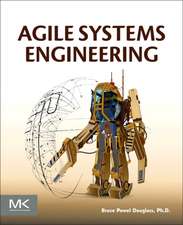Design Patterns for Embedded Systems in C: An Embedded Software Engineering Toolkit
Autor Bruce Powel Douglassen Limba Engleză Paperback – 2 noi 2010
Patterns are given in UML (Unified Modeling Language) with examples including ANSI C for direct and practical application to C code. A basic C knowledge is a prerequisite for the book while UML notation and terminology is included. General C programming books do not include discussion of the constraints found within embedded system design.
The practical examples give the reader an understanding of the use of UML and OO (Object Oriented) designs in a resource-limited environment. Also included are two chapters on state machines. The beauty of this book is that it can help you today.
Design Patterns within these pages are immediately applicable to your project. It addresses embedded system design concerns such as concurrency, communication, and memory usage. Examples contain ANSI C for ease of use with C programming code.
Preț: 336.43 lei
Preț vechi: 392.12 lei
-14% Nou
64.40€ • 69.97$ • 54.13£
Carte tipărită la comandă
Livrare economică 14-28 aprilie
Livrare express 14-20 martie pentru 107.79 lei
Specificații
ISBN-10: 1856177076
Pagini: 472
Ilustrații: illustrations
Dimensiuni: 191 x 235 x 25 mm
Greutate: 0.84 kg
Editura: ELSEVIER SCIENCE
Public țintă
Embedded software developers/programmers; embedded systems designers/developers/architectsCuprins
Chapter 1: What Is Embedded Programming?
Chapter 2: Embedded Programming with the Harmony/Embedded Development Process
Chapter 3: Design Patterns for Accessing the Hardware
Chapter 4: Design Patterns for Embedding Concurrency
Chapter 5: Design Patterns for Embedding Distribution
Chapter 6: Design Patterns for Memory
Chapter 7: Design Patterns for State Machines I: Implementing State Machines
Chapter 8: Design Patterns for State Machines II: Optimizing State Machines
Appendix A: UML Notation
Notă biografică
Embedded Software Methodologist. Triathlete. Systems engineer. Contributor to UML and SysML specifications. Writer. Black Belt. Neuroscientist. Classical guitarist. High school dropout. Bruce Powel Douglass, who has a doctorate in neurocybernetics from the USD Medical School, has over 35 years of experience developing safety-critical real-time applications in a variety of hard real-time environments. He is the author of over 5700 book pages from a number of technical books including Real-Time UML, Real-Time UML Workshop for Embedded Systems, Real-Time Design Patterns, Doing Hard Time, Real-Time Agility, and Design Patterns for Embedded Systems in C. He is the Chief Evangelist at IBM Rational, where he is a thought leader in the systems space and consulting with and mentors IBM customers all over the world. He can be followed on Twitter @BruceDouglass. Papers and presentations are available at his Real-Time UML Yahoo technical group (http://tech.groups.yahoo.com/group/RT-UML) and from his IBM thought leader page (www-01.ibm.com/software/rational/leadership/thought/brucedouglass.html).
Descriere
A recent survey stated that 52 per cent of embedded projects are late by 4-5 months. This book can help get those projects in on-time with design patterns. The author carefully takes into account the special concerns found in designing and developing embedded applications specifically concurrency, communication, speed, and memory usage.
Patterns are given in UML (Unified Modeling Language) with examples including ANSI C for direct and practical application to C code. A basic C knowledge is a prerequisite for the book while UML notation and terminology is included. General C programming books do not include discussion of the constraints found within embedded system design.
The practical examples give the reader an understanding of the use of UML and OO (Object Oriented) designs in a resource-limited environment. Also included are two chapters on state machines. The beauty of this book is that it can help you today.
Design Patterns within these pages are immediately applicable to your project. It addresses embedded system design concerns such as concurrency, communication, and memory usage. Examples contain ANSI C for ease of use with C programming code.











